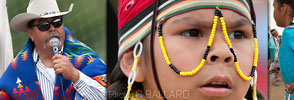 |
 |
 |
Publishing Corner: Indian Community: Science & Wonder Indian Heros: California Indian Art: CALIE Library: Academic Financial Aid: Tribal Governments: Indian Gaming: |

Army Colonel Van Thurman Barfoot (retired), Choctaw American Indian World War II veteran and Congressional Medal of Honor recipient. VAN T. BARFOOTRemember the guy that wouldn't take the flag down in his yard? by author unknown (edited by CALIE)
Col. Van Barfoot (retired), 90, AP/Richmond Times-Dispatch/Eva Russo photo.
Then at the age of 25 (May 23, 1944) — on a foreign WWII battlefield near Carano, Italy — Technical Sergeant Barfoot set out alone on foot to flank German machine gun positions and stop the deadly rain of enemy bullets that were killing his fellow soldiers. Barfoot advanced through a minefield, took out three enemy machine gun emplacements with hand grenades and expert fire from his Thompson submachine gun.
German machine gun position, World War II. If that wasn't enough for a day's work, young Sergeant Barfoot then picked up a bazooka, took on and destroyed one of the three advancing Mark VI tanks that German commanders ordered in to spearhead their fierce heavy-armored counter attack on Barfoot's platoon position in an unsuccessful effort to retake their lost machinegun positions.
Mark IV German tank, WW2 historical photo. As the tank crew members dismounted their disabled tank, Sgt. Barfoot killed three of the German soldiers outright with his tommy gun. Barfoot then continued further into enemy terrain and destroyed a recently abandoned German fieldpiece with a demolition charge placed in the breech. While returning to his platoon position, Sgt. Barfoot, though greatly fatigued by his Herculean efforts, assisted two of his seriously wounded men 1,700 yards to a position of safety. Barfoot is credited with capturing and bringing back 17 German prisoners of war (POWs) to his platoon position that day. But even those heroic efforts probably didn't make much news back home either, given the scope and magnitude of the war, however, they were to earn then Technical Sergeant Barfoot a U.S. Congressional Medal of Honor, and an honorable place in American history.
Promoted to lieutenant, LT Van Barfoot pictured in the field beside a general while wearing his Congressional Medal of Honor around his neck, L Company, 157th Infantry Regiment.
Barfoot pictured as a young Army lieutenant, and years later as a highly-decorated colonel. Barfoot (now retired) served heroically in World War II, Korean and Vietnam wars. So what is the news flash here? What finally did make national news headlines back home was a local neighborhood association's quibble over how the famous 90-year-old war hero chose to fly the American flag outside his suburban Virginia home. It seems the rules stated a flag may be flown on a house-mounted bracket, but, for decorum, items such as Barfoot's 21-foot flagpole were socially unsuitable.
The controversial 21-foot flagpole on Barfoot's property, Jared Campbell Photography photo. Barfoot had been previously denied a permit for a flagpole — he erected it anyway despite the permit issue — and then he ended up facing court action unless he took it down. After the story made national TV news headlines, the neighborhood association rethought its position and agreed to indulge the old hero who dwells among them. "In the time I have left I plan to continue to fly the American flag without interference," Barfoot told Associated Press reporters. As well he should. And if any of Barfoot's neighbors still takes a notion to contest him, they might want to read his Medal of Honor citation. It indicates he's not real good at backing down:
As a Native American Indian recipient of the Congressional Medal of Honor, Mr. Barfoot is one of only five American Indians that have been distinguished by receiving the United States' highest military honor (the Medal of Honor) during the 20th century. Awarded by the United States Congress for military heroism "above and beyond the call of duty," these American Indian warriors exhibited extraordinary bravery in the face of the enemy and, in two cases, made the ultimate sacrifice for their country.
Barfoot talks about his military service ribbons with reporters during a video interview.
Col. Van Barfoot, 90, (retired) pictured outside his home folding an American flag, AP/Richmond Times-Dispatch/Eva Russo photo. Please see CALIE's complete list of all 19th and 20th century American Indian Medal of Honor recipients. WE LIVE IN THE LAND OF THE FREE, ONLY BECAUSE OF THE BRAVE! IN GOD WE TRUST! WHO PRODUCED THIS BLOG?
|
CALIF INDIAN EDU NETWORK: AHMIUM.org | SDICENTER.org | APAPAS.com
—
WEB SITE DESIGN
www.calie.org COPYRIGHT 2008-Present • ALL RIGHTS RESERVED









